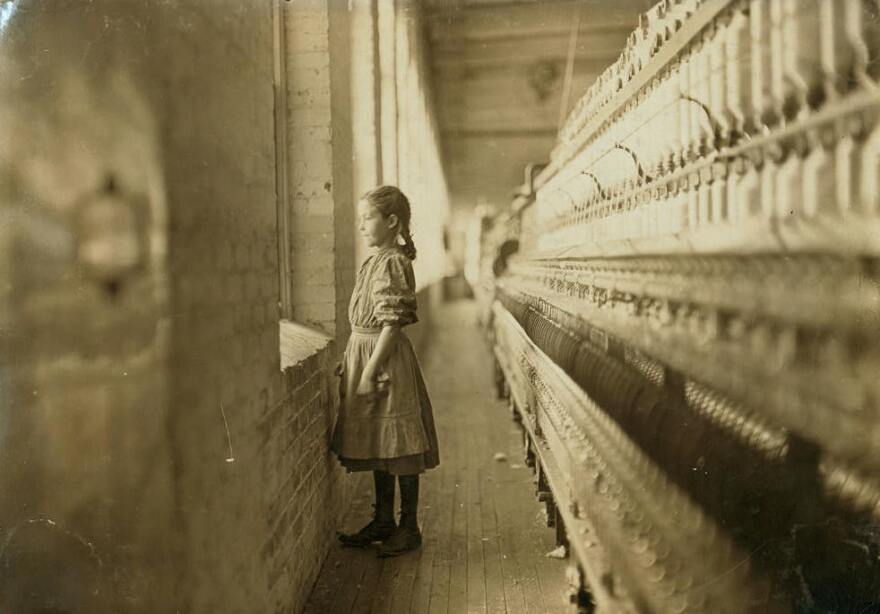You’ve probably seen the work of photographer Lewis Hine. Perhaps his most famous photos are of the construction of the Empire State Building. But more than two decades before taking those pictures, Hine was in the Carolinas documenting child labor abuses in textile mills for the National Child Labor Committee. And one of his most memorable photos was of a little girl in Lincolnton staring out the window of a cotton mill. Other than being referenced as a cotton mill spinner, the girl was never identified – until now, that is. A historian named Joe Manning has identified the girl, and Mr. Manning joined us from his home in Massachusetts.
Kevin: So who was this girl from Lincolnton, North Carolina?
Manning: Her name was Lalar, L-A-L-A-R, Blanton.
Kevin: And when did you first come across this picture? How was this picture presented to you?
Manning: I saw the picture about 2009. I was already working on many other pictures like this. So immediately I jumped at the opportunity of trying to identify her.
Kevin: And when was this photo taken?
Manning: 1908. December.
Kevin: So we're talking over 100 years of this girl in the photo not being identified. Describe the process that you went through to try and identify her.

Manning: There is almost nothing you can do in the beginning besides publicize the photo in the area it was taken. So in 2009 I contacted the Lincolnton newspaper and convinced them to publish the photo and to just ask the readers if they recognized it. That's been successful for me a number of times, but in this case it was not. Then about a year ago, I thought that maybe I could figure out from the 1910 census who the possibilities were as far as who this girl was. Maybe somebody would be looking up that specific name while doing a search of their ancestry, and it would pop up on my site because the search term would bring my site up. So I went into the 1910 census, and I looked at everyone who was about her age, who was white. And then she was in another photo with her sister, so I figured she would have to be in a household with another person who was a girl who was also about that age, and I came up with twelve (names). And one of them was listed as Lala Blanton. So I put that name in among the others, and two months later Lalar's granddaughter was looking up all the different variations of the spelling of her first name, put in Lala Blanton, and up pops my page with the picture.
Kevin: And how did you go about confirming that this was her in the photo?
Manning: She (Lalar's granddaughter) sent me some photos that she had of Lalar. Unfortunately none as a child, but some as an older person. She looked like her in every single way. So finally I emailed the pictures to a friend of mine who is a nationally recognized genealogist and face recognition expert, and she emailed me back a couple of days later and she said it's 100 percent. It's her.
Kevin: How did the family react when they found out that this was their grandmother in this photo?
Manning: Oh boy, the emotions were amazing. In this particular case, the granddaughter whom I worked with mostly and interviewed her, looked up to her grandmother very much. She (the granddaughter) had some problems as a child where she couldn't live with her parents for a while so she lived with her grandmother. So her grandmother was really the most important person to her in her early life. She just adored her. So for her to realize that her grandmother was in this position having to work in a mill at that age, and knowing how protective her grandmother was of her, she could almost see that maybe because she worked in a mill, she was protective and tried to create a good childhood for her granddaughter. It was really joyous for her on one side to know that her grandmother was depicted in this way and had become a historical figure, but she was also very sad about it because she saw what her grandmother faced.
Kevin: Give us a little background of these photos from these mills by Lewis Hine.
Manning: Well Hine was hired by the National Child Labor Committee in 1908, but by that time he was already famous for taking pictures of Ellis Island, and also taking pictures for a project in Pittsburg on the steel industry. Hine was just going from mill to mill, to show people that there was in fact child labor going on. It was a way of forcing people to bear witness to it.
Kevin: Were these photos iconic and significant at the time, or did they become more iconic later on?
Manning: Well they were circulated a lot in the National Child Labor Committee's efforts to get child labor laws passed, but outside of the circles that they were in - no - the pictures were not well known. They really took wing in a sense when the pictures became digitally available. The Library of Congress' digitization of the photos, and the making of them available for free to the public - when that was launched 20 years ago - that really made those pictures iconic.
Joe Manning is an author and historian. He joined us from his home in Massachusetts. For more information on Manning's search for the identity of the girl in the Lewis Hine photo, click here.

